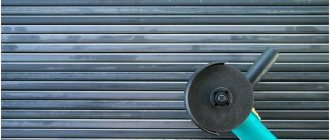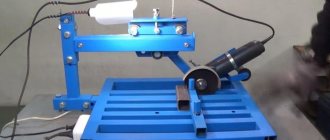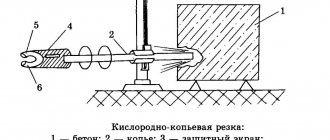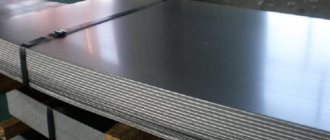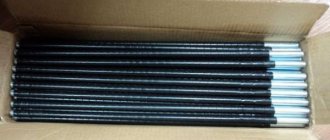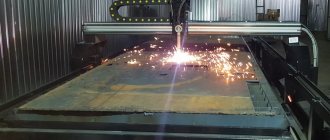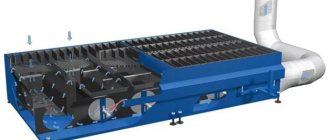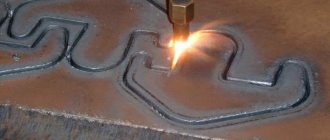Today, profile flooring is a popular material in construction. Therefore, quite often questions arise about the possibility of cutting sheets yourself, what is the best way to cut corrugated sheets and about ways to prevent corrosion of their edges.
In this article, we will analyze the advantages and disadvantages of using tools for cutting profiled sheets known to craftsmen.
Corrugated sheets are steel sheets coated with zinc and a protective colored layer of polymer, which is easily bent and resistant to deformation, protecting the steel from destruction and maintaining color fastness.
In appearance, it resembles slate, and has alternating trapezoidal, rectangular bulges and depressions of different widths and depths. The metal for the production of corrugated sheets has a thickness of up to 1 mm, which is the peculiarity of cutting parts of the required size.
There are several options for cutting corrugated sheets: manually, using power tools, or using machine tools.
Return to content
How to cut sheet metal
DIY sheet metal cutting. How to evenly cut a sheet of metal using improvised materials. Cut out the circle and other shapes.
Sheet metal is a common building material used to make fences, gutters and canopies. You can often find ready-made galvanized steel products on sale, such as ridges or pipes for draining rainwater from the roof. But what if the product is of non-standard size and you need to cut sheet metal yourself?
Mechanical types of sheet metal cutting
Mechanical cutting of metal is a contact processing method in which the surface of the tool interacts with the material. The cutting element, as a rule, is also made of metal, but of higher hardness.
The group of devices for mechanical cutting of sheet metal includes scissors, a saw and cutters. A special type of mechanical processing of metal sheets is cutting. Impact cutting or chopping with a guillotine is usually used at the stage of creating workpieces.
Sheet metal machining can also be performed using the following equipment:
- band saw machines (LPS);
- guillotine;
- disk machines;
- lathes with cutters installed on them;
- slitting units.
1. Cutting with a band saw.
It is advisable to use a band saw for processing long metal. This device is the main working element on a band saw machine (LSS). The operating principle of the saw is similar to that of a conventional hacksaw. The saw blade is enclosed in a large diameter band, one side of which has special teeth. Continuous movement of the belt is ensured by rotating pulleys connected to an electric motor. The average operating speed of the LPS is 100 mm/min. The working blade for such machines is usually made of carbon steel or a bimetallic alloy.
The advantages of using LPS include: accuracy, availability, favorable cost of equipment, the ability to perform both straight and angular cuts, efficiency (minimum amount of waste).
Modern machines for cutting sheet metal are equipped with electronics and additional elements, which allows them to be included in the production line if necessary.
Tools for cutting metal sheets
Initially, when choosing tools, you need to decide on the tasks. Not only the amount of work matters, but also the time frame, the accuracy of the cut and the possibility of damage to the protective coating. Electric scissors are often used at construction sites. However, you should not expect a very smooth edge. The advantage of such a device is the speed of work.
How to cut a sheet of metal straight? At home, the problem can be solved quite simply - by using metal scissors. But this method requires a lot of time and physical effort. Scissors will not work if you need to cut long strips. The most even cut can be obtained using slotted scissors. This tool is quite expensive and is usually used by professionals.
Equipment for cutting profiled and galvanized sheets:
How to cut a corrugated sheet to maximize the preservation of the protective properties of its coating?
Many builders prefer to use an electric saw with a disk for cutting corrugated sheets. This tool has a number of advantages:
- The rotation speed of a circular saw is almost 2 times less than that of an angle grinder, so the metal of the corrugated sheet does not melt under the action of the teeth of the disk for cutting corrugated sheets, but is removed in the form of small sawdust.
- Ability to quickly cut large quantities of sheets
- You can buy a disc for cutting corrugated sheets at any construction supermarket, in the same departments where abrasive cutting wheels are sold.
However, you should be very careful when using a power tool with a rotating wheel, as pieces of metal produced during cutting can cause injury. Therefore, this tool requires certain skills to operate it and is not suitable for beginners.
If you need to cut a small number of sheets, then a classic tool for cutting corrugated sheets - a hand hacksaw - is perfect for you. It is extremely easy to use, allows you to make a cut of absolutely any shape and is safe even for a person with zero construction experience. Of course, it is also possible to get injured from using a hand saw, but such an outcome is extremely unlikely compared to other tools.
Read also: How to make a sheet of metal from a pipe
But this method also has its drawbacks. The main one is the large amount of time it takes to complete the work. In addition, you will need a special table to cut corrugated sheets.
Another option is to use a hand or electric saw. With their help, the work will be completed faster, but with their help you can only cut corrugated sheets in a straight line.
Unlike the previous method, cutting corrugated sheets with a jigsaw allows you to make curved cuts of any shape. Such adjustment is often necessary when installing roofing coverings where ventilation and chimney pipes pass through the roof. However, before cutting a profiled sheet with a manual or electric jigsaw, you need to carefully mark the sheet so as not to make a mistake with the dimensions of the cutouts.
The disadvantage of this method is that cutting corrugated sheets with a jigsaw is only possible with a profile height of no more than 20 mm. When cutting higher profiles, the blade tears the metal and often breaks.
Finally, if it is necessary to adjust profiled sheets of small thickness, you can use scissors to cut corrugated sheets. These can be either ordinary hand scissors for cutting sheet metal, or special electric scissors for cutting corrugated sheets.
Shears for corrugated sheets can be of three types - cutting, knife and spline. The most accurate cut is obtained if you use slotted scissors for corrugated sheets. They are equipped with a special head that allows you to make an accurate cut without any deformation or distortion.
Electric shears are very popular among professional builders. They are considered one of the most convenient tools for cutting corrugated sheets.
In addition to conventional manual and electric shears, nibblers are also used. They cut the profile sheet along two parallel straight lines, which helps avoid bending the sheet. Before cutting the corrugated sheet, using a special handle, the matrix holder can be rotated at an angle of 90° to the cutting line. This allows you to cut a profile curved at a right angle without burrs.
The only drawback of these tools is their high cost and, most importantly, an extremely narrow scope of application. If cutting corrugated sheets is not your daily routine, then buying nibblers or electric shears does not make sense.
Many roofers use such tools for corrugated sheeting as drill attachments. If you have certain skills and use a cordless drill, this attachment is very convenient for cutting and fitting corrugated sheets in hard-to-reach places.
As you can see, the choice of possible tools is quite large, and each option is optimal for a certain situation and inferior to its analogues in another. Therefore, it is quite difficult to say unequivocally what is better for cutting corrugated sheets without reference to a specific task. A specialist decides how to cut a profiled sheet in each individual case, taking into account the complexity of the cutout shape, the possibility of access to it and his personal skills and preferences.
How to cut a sheet of metal with a grinder
One of the fastest ways to cut galvanized sheets is cutting with a grinder. Among the disadvantages of this processing are torn edges, which will have to be additionally cleaned and smoothed. A grinder is not suitable for cutting corrugated sheets, since sparks during cutting can damage the polymer coating. But for simple work that does not require high precision and accuracy, an angle grinder is quite suitable.
Please note that when using such a power tool, purchase a special disc that will not damage the protective coating on the galvanized sheet. After cutting the corrugated board, the edges must be cleaned and coated with special paint. This equipment can be used if you are building a shed from corrugated sheets or making a canopy. In this case, you do not have to purchase a special and expensive tool.
- choose discs with carbide teeth;
- operate at low speeds;
- Treat the cut areas with a special anti-corrosion coating.
Hand-held power tool for cutting corrugated sheets
The most popular, practical and quick to use are power tools. A grinder, jigsaw, electric scissors and a hand-held circular saw can be used for cutting Chishmin corrugated sheets.
Modern construction is almost impossible without the use of concrete. To obtain high-quality concrete, you need to choose the right concrete mixer.
Here you will learn how to choose the right drill for construction work.
The link - https://vse-postroim-sami.ru/equipment/power-tools/2176_kak-vybrat-shurupovert/ - provides detailed information on choosing a screwdriver. This article discusses the types and main characteristics of screwdrivers.
Is it possible to cut corrugated sheets with a grinder?
A manual angle grinder, popularly called an angle grinder, is a widely used tool for cutting various metals, and corrugated sheets are no exception.
Many manufacturers of corrugated sheets do not recommend using a grinder, since the high temperature effect on the polymer layer has a negative effect. Despite this, some craftsmen and sellers of profiled sheets use it as the lightest and most practical cutting tool.
So is it possible to cut corrugated sheets with a grinder? And how to cut corrugated sheets with a grinder with minimal damage to the coating?
Attention! The main rule that must be followed when cutting corrugated sheets correctly is that the diameter of the cutting wheel matches the height of the relief of the sheet being cut.
When cutting corrugated sheets with deep relief with a small grinder, it will be difficult to immediately cut the sheet in the lower corners. It will have to be turned over to the other side. It is better to opt for an angle grinder with the largest wheel diameter and disc thickness from one millimeter to 1.6 mm, with teeth made of carbide materials.
It is important that the corrugated sheet does not touch the ground or the surface of the table where the cut is being made. Dust may arise or the desktop may easily become damaged. Using a grinder to cut sheets in the experienced hands of a craftsman allows you to cut out parts of the required geometric shape.
Using an abrasive wheel during work damages the protective coating of the corrugated sheet. The fact is that at the edges of the cut, the abrasive wheel greatly heats the metal. This leads to burnout of the zinc, polymer coating and other layers. In addition, sparks falling on the profile sheet can burn through the protective coating. This reduces the service life of corrugated sheets.
Alternatively, the abrasive disc can be replaced with an aluminum cutting disc. It’s better to use a special disc for cutting corrugated sheets. The edges of such a cut will be straight and neat.
Jigsaw
If the corrugated sheet matches the tool correctly, a jigsaw is a completely suitable option. It is better to use a professional-grade jigsaw, since a household-grade tool is low-power and sheets thicker than 75 mm are almost impossible to cut. The optimal sheet wave depth for a household jigsaw is about 20 mm. It does not burn the protective layer, but it tears the metal.
A professional-class jigsaw capable of cutting C8 profiled sheets, the properties of which are to the taste of buyers.
There are some disadvantages of this tool for cutting corrugated sheets. The sheet to be cut must be installed vertically; therefore, it is necessary to support the already cut strips, for which several assistants will be needed. Saws often break during operation.
Attention! The opinion of experienced craftsmen is that a jigsaw is not the most suitable option for cutting corrugated sheets.
Electric shears - scissors for cutting corrugated sheets
If there is no need for smooth edges, then electric shears are the best tool for cutting corrugated sheets. They cut metal quickly, in one millimeter layer. In addition, you don’t need to put in a lot of effort; the metal is cut automatically.
Slotted electric shears are most suitable for cutting corrugated sheets. It is considered a universal tool, capable of making neat cuts, without bending or deformation during shaped cutting.
Nibblers cut the material along two parallel straight lines, without the need to bend the profiled sheet. These shears for cutting corrugated sheets cope well with sharp turns. For greater convenience, the handle rotates perpendicular to the cutting line. In addition, you can drill a hole in the middle of the profiled sheet and use nibblers to cut in the desired direction.
Upon completion of the work, the edges of the cuts are smooth, without burrs and do not bend.
Hand circular saw
A hand-held circular saw is used to cut corrugated sheets using a disk with carbide teeth. Using a circular saw, cuts are made along a curve with the required radius of curvature.
The downside of this tool is that the protective layer burns out due to powerful revolutions. There may also be jagged edges.
How to properly cut corrugated sheets using a circular saw?
For smoother cut edges you will need a plywood jig. A groove is cut out in the center of the plywood, a kind of landmark.
Cut marks are made on both sides of the corrugated sheet, then the plywood jig is laid down and pressed tightly and cutting is carried out. The metal does not melt, but falls into small sawdust, which is very convenient. A circular saw is more practical for cutting large sizes of corrugated sheets.
So, what is the best way to cut corrugated sheets?
Attention! Having summed up the pros and cons of each power tool for cutting corrugated sheets, we come to the conclusion that the best and most practical are an angle grinder using a special disk for cutting corrugated sheets, a manual circular saw, and slotted electric shears. A jigsaw is more suitable for cutting short sheets.
Return to content
Jigsaw
If you need to cut a circle in a sheet of metal, you should use a jigsaw. It works quite quickly, so you will get a neat hole in a matter of minutes. Among the disadvantages of the equipment are noise and the possibility of a burnt edge when processing profiled sheets.
- it is necessary to use saws with fine teeth;
- you need to choose a reciprocating mode;
- it is necessary to control the inclination of the cutting part;
- rapid failure of consumables.
A circular saw
Sometimes a circular saw is used to cut metal. If you work with corrugated sheets, then the equipment must be turned on at low speeds. Otherwise, the polymer coating may be damaged. To work, you will need a partner to hold the sheet. Among the advantages of this tool is that the work is performed without heating, so you will not damage the protective coating on the profiled sheet. It is best to use an aluminum circle.
To set up fast work with a circular saw, you need to prepare a plywood pattern. The groove is not completely cut out in this sheet. This will be a kind of blank that allows you to preserve the galvanized or polymer coating on the sheet. An excellent tool for cutting metal is a double-blade saw. It, unlike the grinder, does not leave a torn edge and works much quieter. Unfortunately, not every master has such a tool.
How to cut corrugated sheets with a jigsaw?
If you just can’t decide how to cut corrugated sheets, then we advise you to choose a jigsaw unless, of course, you have already purchased other tools. As a rule, this is the best choice for those who decide to independently install roofing in their country house or build a fence from corrugated sheet metal. It is desirable that it has a laser guide.
Read also: Using dinistors in power regulators
This tool is the most versatile tool that can be used to cut corrugated sheets without spending serious effort and having special skills. In addition, it can be used for carpentry work and for cutting down a few dry branches in the garden.
In addition, the jigsaw is very easy to maintain and use. The speed of work is high, the likelihood of injury is minimal, if the file breaks, it can be easily replaced, and even a beginner can handle cutting. All these qualities make the jigsaw an almost ideal tool for this task.
Now let's focus directly on the technology of its use:
- Before cutting corrugated board with a jigsaw, draw a cut line. You can use a regular marker for this.
- Secure the sheet so that it is at least 10 centimeters from the surface and does not move when cutting. You can use regular sawhorses for this.
- Now you can start cutting directly. Don't rely on your eye - use a laser pointer to ensure that the cut line is straight and exactly matches your tasks.
- Try to press the jigsaw tightly against the sheet where possible. This will reduce the risk of the blade breaking.
- Despite the fact that this tool for cutting corrugated sheets is quite safe and has many mechanisms that protect a person from injury, be extremely careful. Hold the sheet by the edge rather than resting your hand on it. And especially do not keep your hand on the cutting line, even if the tool is still at a decent distance.
If you follow all these rules, you can easily cope with cutting corrugated sheets yourself. Moreover, you will do this quickly and without serious harm to the coating of the sheet.
What and how to make a hole in a sheet of metal?
It all depends on the size of the hole. If the diameter is small, a drill will do. If large holes are needed, special drill bits are used. Pay attention to the material from which the horse-drawn horse is made. To process profiled sheets, you should use nozzles with a carbide coating. Processing should be carried out without increasing the temperature.
A jigsaw is used to make a large diameter hole. With this tool, cutting out a circle of large diameter will not be difficult. When working, use a saw with fine teeth
Edge protection against corrosion
Even the use of special tools for cutting corrugated sheets does not guarantee complete protection against damage to the corrugated sheet coating. Only in profiled sheets of galvanized steel of the 1st class of zinc coating thickness, the presence of molecules at the cut site creates a barrier that prevents oxidation of the metal.
Therefore, in order to avoid shortening the service life of the corrugated sheet, it is necessary to apply a special anti-corrosion mastic to the edges of the cut. In addition, you can also paint these places with paint in the color of the protective coating of the profiled sheet. Fulfilling these simple requirements will reliably protect the edges of corrugated sheets in the fitting areas, ensuring the reliability of the profiled sheet throughout its entire service life.
How to join corrugated sheets?
What are the rules for joining profiled sheets? Is it necessary to seal the joints of corrugated sheets? How much overlap is needed for a small roof slope? The answers to these questions are in the article.
Screws for fastening corrugated sheets
Do you want to know how many screws are needed for a sheet of corrugated sheeting? How do screws for corrugated sheets differ from other types of self-tapping screws? How to choose them? Read the article!
DIY roller knife for sheet metal
A do-it-yourself roller knife for sheet metal is a homemade tool, the demand for which is growing every day, which is explained by the productive speed of operation of such a device and its simple design. The mechanical basis is extremely simple, and is based on two metal knives rotating in opposite directions, pressing into the steel plane of the workpiece, which leads to its cutting.
The classic design involves the installation of rotating disks at the top and bottom, classified according to the material of manufacture:
- Parallel roller knives are used for cutting steel sheets into strips, while maintaining good quality of the workpiece.
- Roller knives with one inclined edge - this design, in addition to slicing, allows you to cut workpieces with rounded shapes.
- Roller knives with multiple inclined edges - maintaining a small radius, helps to produce parts with curved lines and rounded shapes.
Design
Roller metal shears, assembled at home with your own hands, have a common essence that remains unchanged - the presence of a cutting knife. It is made from steel alloys with a maximum strength threshold and other characteristics that should be higher compared to similar parameters for steel that will be processed on a cutting machine.
Roller knife device
In practice, it is known that roller knives produced at the factory for cutting metal have a service life of about 30 km of steel sheets, with a caveat to the maximum sheet thickness, which will not exceed 0.5 mm.
Accordingly, if the thickness of the material is higher, then the durability of the tool is reduced. However, nothing prevents you from sharpening the tool and thereby extending its service life.
Industrial types of sheet metal cutting
Metal processing can be carried out in different ways. The specifics of the work depend on the type of equipment used for cutting metal sheets.
At large industrial enterprises, waterjet or thermal cutting is most often used.
1. Heat treatment of sheet metal.
Thermal cutting involves separating metal sheets with a jet heated to extreme temperatures. This type of cutting is also called non-contact cutting, since the tool does not interact with the surface of the sheet material.
Types of thermal cutting: oxygen gas, laser, plasma.
- Oxygen gas cutting of sheet metal.
Oxygen gas processing of sheet metal includes two stages:
- A jet of flame coming out of the cutter is supplied to the starting point of the intended cutting line. Acetylene is used as the working gas.
- After heating the material, the device supplies an oxygen flow, which easily cuts the softened metal. At the same time, oxides are removed.
In order for the cutting quality to be high, the distance between the cutter nozzle and the metal must be the same throughout the entire working process.
We recommend articles on metalworking
- Steel grades: classification and interpretation
- Aluminum grades and areas of their application
- Defects in metal products: causes and search methods
Oxygen cutting is the most economical cutting method and is excellent for cutting low alloy steels. If all the nuances of the technology are observed and the craftsman has sufficient experience, the edge of the sheet metal after oxy-fuel cutting does not require additional processing.
The disadvantage of using this type of cutting is that it can only process metals with low thermal conductivity.
- Plasma cutting of sheet metal.
Plasma cutting is considered a more universal method of processing sheet materials. The first equipment for this type of metal cutting appeared in the second half of the 20th century. The equipment was not only bulky, but also expensive, and therefore only large industrial enterprises could afford its acquisition and use. Over time, equipment has become more accessible, and the popularity of plasma cutting has grown exponentially.
VT-metall offers services:
In this case, metal processing is carried out using a high-speed plasma flow, the temperature of which can reach +30,000 °C. In this case, drops of molten metal formed as a result of melting are instantly blown away by a stream of compressed air. Compared to the previous type of cutting, plasma processing is highly productive, because the temperature of the oxygen gas flow is only +1,800 °C.
It is worth noting that the popularity of plasma cutting is explained not only by its high productivity, but also by a number of other important parameters. Thus, the work process does not require regular refilling of gas cylinders, additives for cutting valuable metals or increased attention to fire safety measures. To work with plasma equipment, you only need electricity and air, which allows you to draw objective conclusions about the simplicity, convenience and economy of the work process.
Plasma cutting of sheet metal can be used to process:
- aluminum and alloys based on it up to 120 mm thick;
- copper up to 80 mm thick;
- alloy and carbon steels up to 50 mm thick;
- cast iron up to 90 mm thick.
If the metal thickness exceeds 120 mm, it is more advisable to use oxy-fuel cutting.
When selecting the optimal equipment for metal processing, it is very important to take into account such properties as thickness and thermal conductivity. Here you need to remember one simple rule: the higher the thermal conductivity of the material being cut, the greater the heat removal and the smaller the possible thickness of the sheet being processed (for example, the thickness of a copper sheet should be less than a stainless steel sheet).
Necessary materials
A machine for cutting sheet metal, constructed with your own hands at home, requires knives, the range of materials for which is very wide, and the choice of one of them mainly depends on the type and thickness of the material that will need to be cut. If you have to work with not the most durable, thin sheet steel, such as aluminum, then the simplest bearings will be the ideal option. But for the required functionality of a roller knife, they lack sharpening, which should be carried out independently along the entire end of the future tool.
The main roller knife is installed on a movable part of the structure with a pressure handle, which, when pressed, clamps the workpiece between two cutting surfaces. The diameter of the bearings directly affects the speed of work performed. That is, the larger the bearing diameter, the higher the production speed on the machine.
Making a roller knife for metal with your own hands
To simplify the work with the tool and make it more convenient, it would be nice to equip the sheet cutter with a guide plane.
The manufacture and installation of this part is not very difficult, and in return it will greatly simplify the entire process. The result is a universal machine with roller knives, which can interact with other metalworking equipment, which can also be easily constructed at home.
Manufacturing instructions
Factory models of cutters sold in stores, even in standard configuration, will cost a large amount. The price of models offered on the market starts from 20,000 rubles. Such conditions are not beneficial for purchasing a tool for home use or a small workshop, and it will be used extremely rarely.
To begin with, the main body of the instrument is designed, which everyone chooses for themselves. The main attribute of the machine is manufactured - a roller knife for sheet metal. The material from which the part is made directly affects the durability and performance of the unit. As mentioned above, the strength characteristics should be significantly higher than the similar characteristics of the material being cut. Otherwise, the minimum problem will be a low-quality cut, forcing the craftsman to clean and process the edges of each cut piece.
Scheme for assembling a roller knife
Do-it-yourself roller metal shears are mostly made from bearings. Sharpening the ends of the part forms the cutting surfaces. The main roller, connected to the drive, is attached directly to the handle. The lower one is installed on the fixed lower part of the machine. If you have skills in processing iron alloys, manufacturing such a device will take a maximum of a little more than a week, including setting up the unit.
Features of metal cutting at home
Circular knives are an excellent replacement for metal shears, having a number of advantages:
- Small dimensions and dimensions.
- Simplicity of design.
- Easy adjustment.
- Convenience and ability to work with a wide range of materials.
Cutting metal with a roller knife
Do-it-yourself sheet metal cutting at home is usually done with cutters or drills. Of course, this approach helps to give the part the desired shape, and at the same time polish the surface. However, it would be much more practical to construct a machine with roller knives with your own hands once (unless, of course, we are talking about cutting scrap metal, since accuracy is not so important there), thereby reducing both the time allotted for processing and minimizing the amount of debris and defects that may occur when using hand tools. To put it simply, circular knives are an excellent replacement for metal shears and even an industrial guillotine.
If you find an error, please select a piece of text and press Ctrl+Enter.
Basic process and safety precautions when cutting sheet metal with an angle grinder
Compliance with safety regulations is the most important point, neglect of which can result in injuries of varying severity.
Here are a few rules that should be followed when cutting sheet metal with a grinder.
- Disk size . It is a mistake to believe that its size can be selected without taking into account the size of the angle grinder. Do not install a large blade without a protective cover on a small tool, otherwise you may put your life in danger. The speed of a small grinder is much higher, so they need appropriate cutting elements. Having installed a large disk, you won’t even have time to draw a cutting line; the toothed circle will simply fly apart after turning it on.
- Direction of rotation . Some workers are not satisfied with the direction of sparks that are observed during standard operation of the tool. So they unroll the casing, rearrange the handle, and start cutting. Arbitrariness in this matter can lead to the fact that when caught on a sharp edge, the cutting disk will fly apart into pieces. Remember - the rotation of the disk should be done “towards you”, and not vice versa.
- Personal protective equipment . The presence of such devices is a prerequisite for working with an angle grinder. Safety glasses, gloves and a respirator will help avoid injury to vital organs.
1. Normal cutting of thin sheet metal.
Cutting metal of small thickness usually does not cause any particular difficulties. The key to a high-quality result in this case is attentiveness and accuracy. It is worth noting that when processing thin metal sheets, the cutting disc often “bites.” Before starting work, you need to make sure that there are no defects on the cutting surface of the circle. Their presence can lead to splitting of the toothed disc.
The cutting line should start from the far edge of the sheet (it turns out that the master is, as it were, pulling the grinder towards himself). The cutting disc should not be immersed too deeply into the material (maximum 5-6 mm). The correct direction of movement of the tool and a shallow immersion depth will help to avoid the disc getting caught. And vice versa - excessive immersion of the cutting element will lead to a decrease in the contact area, snags and subsequent splitting of the disc.
2. Cutting thick sheets of metal with a grinder.
If the thickness of the sheet metal is more than 8 mm, then you should move the tool away from you rather than towards you. However, if you simply cut along the drawn line, you will not get a perfectly straight edge. In addition, you can overexert your hand, because you will have to constantly control the movement of the grinder.
To facilitate the work process, installing a steel angle at the cut site, which is pressed against the sheet with clamps on both sides, will help. Now you can walk along the drawn line several times, touching the corner a little so that you get a small indentation (no more than 1-2 mm). After the recess is made, you can remove the corner and proceed directly to metal processing. This way the cutting disc will not leave the intended line, and the edge will be perfectly straight.
3. Another cutting option.
The first stages of the work completely coincide with the method described above: a line is drawn, a corner is laid and pressed. The peculiarity is that the recess in this case is made a little deeper - about 4-5 mm. After removing the corner, the remaining metal can simply be broken off, and the edge can be processed using an angle grinder with a grinding disc. It is worth noting that such processing does not guarantee a high-quality result, so the second method is used much more often.
The grinder allows you to quickly and efficiently process sheet metal, but successful use of this tool is possible only if you have sufficient skills and comply with all safety regulations.
List of tools suitable for cutting
You can cut profiled sheets with the following devices:
- electric circular saw with saw blade for steel;
- hand saw;
- jigsaw;
- hand scissors for metal;
- hand nibblers;
- electric scissors - die-cutting, knife, slotting;
- The “Cricket” drill attachment is an analogue of electric nibblers.
All of the listed types do not generate sparks during operation and operate on the principle of cold cutting. Electrical devices are available in two versions according to the type of power supply: wired and battery-powered.
It is theoretically possible to cut corrugated sheets with a grinder, but experts do not recommend using this tool. Galvanized steel, which is the basis of the material, and the protective coating on both sides melt at a distance of up to 5 mm from its impact. This causes edge corrosion. The second risk factor is sparks. Once on the surface, they damage the polymer coating.
Is it possible to cut corrugated sheets with a grinder?
The greatest damage to the protective coating of corrugated sheets is caused by heating to high temperatures that occurs during the cutting process. Therefore, the use of gas cutting equipment for these purposes is completely excluded. For the same reason, you cannot cut corrugated sheets with a grinder.
The fact is that when cutting with a high-speed tool with abrasive wheels, the metal at the cut site simply burns. Along with it, the protective coating also burns, not only along the cut line, but on both sides of it. The width of the damaged area is usually 3-5 mm, which leads to the occurrence of so-called edge corrosion.
In addition, sparks flying from under the abrasive wheel are also dangerous. Due to the high temperature, they can damage the polymer coating at a distance of several tens of centimeters from the cut site.
Cutting corrugated sheets with a grinder is possible only in one case - if, before cutting the corrugated sheets, the abrasive wheel is replaced with a cutting disc for corrugated sheets with fine teeth. However, even in this case, using this tool is not recommended, since such a measure will simply reduce the amount of damage, and not remove it altogether.
Design
Roller metal shears, assembled at home with your own hands, have a common essence that remains unchanged - the presence of a cutting knife. It is made from steel alloys with a maximum strength threshold and other characteristics that should be higher compared to similar parameters for steel that will be processed on a cutting machine.
Roller knife device
In practice, it is known that roller knives produced at the factory for cutting metal have a service life of about 30 km of steel sheets, with a caveat to the maximum sheet thickness, which will not exceed 0.5 mm.
Accordingly, if the thickness of the material is higher, then the durability of the tool is reduced. However, nothing prevents you from sharpening the tool and thereby extending its service life.
Hand tool
To cut short sheets of corrugated sheets, use a hacksaw and a hand jigsaw, the relief height of which is no more than 25 mm. When cut, the sheet covering is subject to less destruction compared to a grinder. The cut edges are smooth, without jagged edges. No special physical effort is required. The downside is that it is difficult to make curved cuts, and a special table is needed to cut the sheet.
Using a jigsaw, cut the sheets lengthwise and crosswise at high speeds, using a fine-toothed file. To prevent the sheet from vibrating, it must be pressed.
A jigsaw is used to refine complex lines in geometry after working with power tools. The downside is that cutting thin strips with a jigsaw will be extremely inconvenient.
Not widely used, but easy to use, are scissors for cutting metal. Sheets of corrugated sheets are cut relatively quickly and without much effort, but the edges may be jagged. This is not so scary, since the corrugated sheet can then be covered with the next sheet.
Warning: In general, hand tools are useful for small jobs. For example, installing a fence. They are not as fast as electrical appliances, however, they retain a protective layer.
Return to content
Necessary materials
A machine for cutting sheet metal, constructed with your own hands at home, requires knives, the range of materials for which is very wide, and the choice of one of them mainly depends on the type and thickness of the material that will need to be cut. If you have to work with not the most durable, thin sheet steel, such as aluminum, then the simplest bearings will be the ideal option. But for the required functionality of a roller knife, they lack sharpening, which should be carried out independently along the entire end of the future tool.
The main roller knife is installed on a movable part of the structure with a pressure handle, which, when pressed, clamps the workpiece between two cutting surfaces. The diameter of the bearings directly affects the speed of work performed. That is, the larger the bearing diameter, the higher the production speed on the machine.
Making a roller knife for metal with your own hands
To simplify the work with the tool and make it more convenient, it would be nice to equip the sheet cutter with a guide plane.
The manufacture and installation of this part is not very difficult, and in return it will greatly simplify the entire process. The result is a universal machine with roller knives, which can interact with other metalworking equipment, which can also be easily constructed at home.
Manufacturing instructions
Factory models of cutters sold in stores, even in standard configuration, will cost a large amount. The price of models offered on the market starts from 20,000 rubles. Such conditions are not beneficial for purchasing a tool for home use or a small workshop, and it will be used extremely rarely.
To begin with, the main body of the instrument is designed, which everyone chooses for themselves. The main attribute of the machine is manufactured - a roller knife for sheet metal. The material from which the part is made directly affects the durability and performance of the unit. As mentioned above, the strength characteristics should be significantly higher than the similar characteristics of the material being cut. Otherwise, the minimum problem will be a low-quality cut, forcing the craftsman to clean and process the edges of each cut piece.
Scheme for assembling a roller knife
Do-it-yourself roller metal shears are mostly made from bearings. Sharpening the ends of the part forms the cutting surfaces. The main roller, connected to the drive, is attached directly to the handle. The lower one is installed on the fixed lower part of the machine. If you have skills in processing iron alloys, manufacturing such a device will take a maximum of a little more than a week, including setting up the unit.
